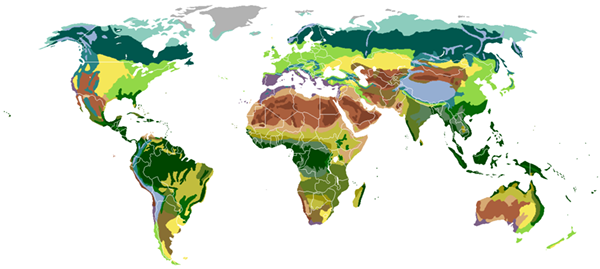Vernacular Dwellings
While the folk architecture of the world is extremely diverse, often almost the same types of buildings appear on different continents. Habitatio seeks the roots of this exciting phenomenon in the context of geographical location, climatic conditions, vegetation, lifestyle, and work.
The most distinctive characteristic of folk architecture is that the building process does not involve well-defined trades or tradesmen—instead the entire construction is generally carried out by the community of the inhabitants. There are no architects, as the design of every house closely follows existing patterns. Folk dwellings are not made of specialised building materials; everything is made of whatever is readily available in the vicinity. Specialised tools and equipment are also absent as the tools used in the construction of houses are the same as those used in the inhabitants daily work. These four conditions not only affect the construction of the building but also ensure the quality of the end result. If people use familiar materials and tools, and tried and tested plans to build houses they will live in themselves, generally in the long term, then it is natural that functional, durable, aesthetically valuable buildings will be the result.
Vernacular (or popular) architecture is less strictly defined and may be influenced by contemporary developments and employ industrially produced materials and products. There are borderline cases, where a building may be said to be classed as vernacular architecture in many regards. In developing countries, the residents of slums or shanty towns also build their own houses. They use whatever materials and components they can find, and have no specialist tools. They do not use strictly defined patterns perfected over long centuries but may apply certain traditional methods, which means that the buildings in one place may somewhat resemble each other, but they cannot be typified to the same extent as well-known examples of folk architecture. The townhouses of ancient times followed relatively precise patterns and were made of the building materials to hand, but were built by specialised masons, carpenters and other tradesmen, so it cannot be said that their inhabitants built these houses themselves or that they used everyday tools. Replicas of folk dwellings, built for tourists, which are traditional in appearance are becoming more and more common. These may even be mistaken for folk dwellings from a distance, but the attentive observer will be disappointed to find that they are not authentic in any way. People did not build these houses for their own use, they are often built with commercially produced materials and the original designs are simplified in a sloppy fashion.
The vernacular residential architecture of five continents cannot be comprehensively presented by just 40 examples, and this is not the purpose of this collection. It does aim, however, to illustrate the great variety of vernacular buildings in as many respects as possible. We wanted to include examples of houses in deserts, rain forests and polar regions, of tents and caves, of houses made of wood, stone, and mud (cob/adobe), and of dwellings which house not one family but a whole village. The types selected are widespread, but where possible not the most well-known examples.
Examples of folk architecture are continuously and inexorably disappearing from the face of the Earth. On some continents the folk houses that can still be seen today are virtually all reconstructed, or the last examples were taken to be exhibited in open-air museums (skansens). Elsewhere, however, people build and live in traditional homes in much the same way as they have done for centuries. These places are far from the centers of civilization, and the existence of many of them is only confirmed by satellite photography.
In the places where folk architecture survives, every single building is built according to a strict set of rules. These rules are always shaped by the local culture. Folk architecture can be thought of as essentially a question of culture. It is conceivable that at some time, long ago, the patterns that were subsequently to be followed evolved in unknown circumstances, and with the passage of time the community only modified them (as little as possible) when it was unavoidable. The mechanism by which these patterns were passed down is also important, and at least as worthy of attention is the way they evolved. The following sections will examine the functioning of climate zones, the connection between biomes and climatic conditions, and the correlations between vegetation and building materials. All this will help us to understand why the dwellings of peoples who live distant from each other, but in similar climatic conditions do not greatly differ from each other. Thus the tents of the Chukchis of the Russian Far East, the Nenets of northern Siberia and the Sami people in the Nordic countries almost all look the same as the Tipis of the North American Indians.
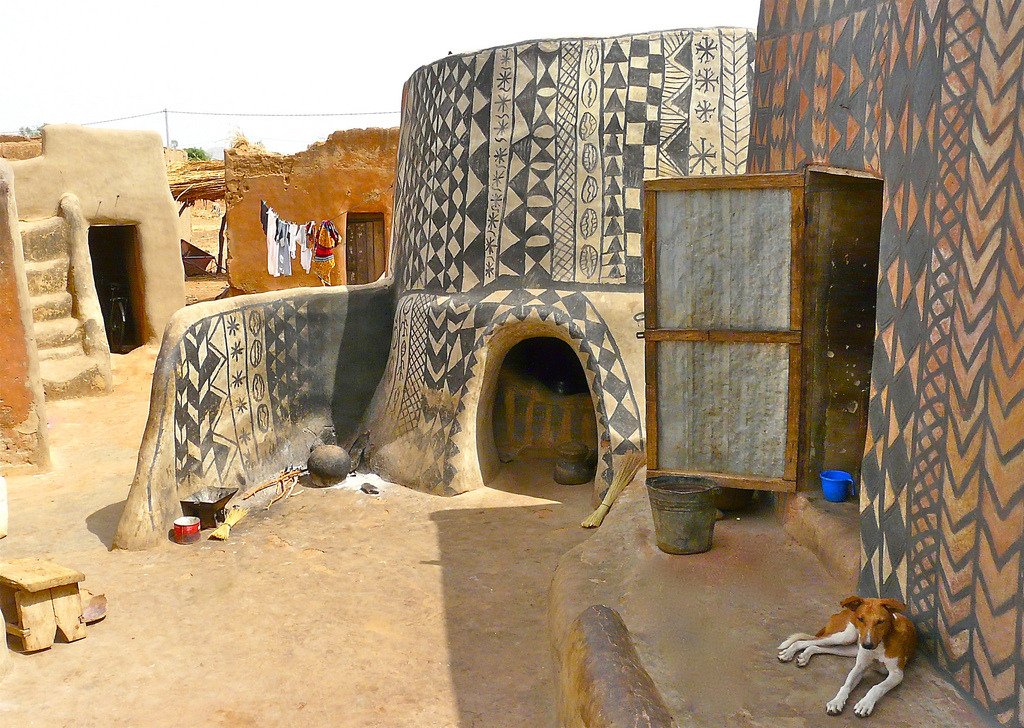
© Rita Willaert / source: designboom.com
Climatic zones
In 1972 the crew of Apollo 17 took the famous photograph known as the Blue Marble. This was the first photograph in which the whole Earth is visible and fully illuminated by the sun. The planet really is blue, or rather blue and white—the brown patch of Africa and the Arabian Peninsula scarcely affects the overall picture. After three decades, thanks to the rapid development of artificial satellites, the Blue Marble gained a new meaning when in 2002 NASA released a composite image showing the whole globe with a resolution of 1km/pixel. This was followed by an image called Blue Marble Next Generation, with twice the resolution, in 2005. Since then they released Blue Marble 2012, as the march of progress is unstoppable, and thanks to the ever-improving techniques the planet is no longer just blue and white—the colours are realistic and the details clear. ![]()
We are in a fortunate position today. Satellite imagery and computer animations make it relatively easy to visualize the workings of our planet’s atmosphere. We know that it gets increasingly warm from the poles to the equator. One might suppose that this would lead to a constant movement of air, whereby air is transported from the poles to the equator where it would then rise, accompanied by constant rainfall and in the highest levels of the atmosphere it would travel back to the Poles. The climate does not work like this, though, as due to the rotation of the Earth the air currents change course, and only reach a third of the way to their destinations, forming three circulation cells in each hemisphere. At the points where the cells meet, rising and falling air currents form, which causes tropical rainfall and the aridity of the deserts.![]()
The theoretical model of global air circulation is also influenced by other factors. As the seasons change the zones of precipitation and dryness move around, and therefore the areas of true desert or rainforest are smaller than the transitional regions. The oceans and seas play a significant role in making temperatures more uniform, and another point to take into consideration is that precipitation does not readily reach the interior of the continents, and so the inland areas of Asia are dryer than might be predicted by the model.![]()
As the collection and recording of temperature and precipitation data became more systematic, it became possible to establish useful, functioning climatic categories. The most widely accepted system was developed by Vladimir Köppen in 1884 and is still used today in a much-modified form. It consists of five main climate categories: tropical, dry, temperate, continental and cold (polar/alpine), with 28 (sometimes 29 or 30), empirically defined sub-categories.![]()
![]()
The formation of various types of soils is a result of varying climatic conditions (temperature fluctuations, wind, frost, rain). At the level of the biome, the compositions of the ecological communities of the major climate zones (plants, animals, soil organisms) depend on the climatic conditions. There are various classification schemes for biomes used at present, of which the WWF’s system of 14 terrestrial (land) biomes is the most widely accepted. ![]()
![]()
Biomes and building materials
The 14 biomes can be divided into three main groups in terms of tree coverage: there are forested, semi-forested and dry areas. The most significant areas of forest are found in the tropics and the sub-arctic regions. The transitional areas originally consisted of wooded grassland savannahs and steppes but as a result of human activities the formerly forested territories of Europe now also belong in this category. Dry areas include not only deserts and semi-deserts, but also polar regions with little precipitation.![]()
![]()
Forested, semi-forested and dry areas are typically found in the following bands or zones from the poles to the Equator:
– Tropical and subtropical forested regions (rain forests, monsoon forests) ![]()
![]()
![]()
![]()
– Tropical and subtropical transitional areas (savannahs) ![]()
![]()
– Dry regions (deserts, semi-deserts, arid mountain ranges) ![]()
![]()
– Transitional areas of temperate climate zones (steppes, Mediterranean type regions) ![]()
![]()
– Forested areas of Continental and temperate zones (coniferous forests, broad-leaved forests) ![]()
![]()
![]()
– Cold regions (tundra) ![]()
In forested regions folk dwellings are made almost exclusively of wood and plant materials (brush). Even simple shade roofs or the roof structures of huts require a material that is rigid, easily shaped and available in several metre lengths, and bamboo or wood is the most suitable for this. Leaves, creepers, and other vegetable matter can be used in many different ways for binding, roof covering, partitioning space and filling in frameworks.
The various transition areas are typically located between forests and dry areas, and their characteristics change gradually. As wood becomes increasingly rare and valuable it is substituted with whatever is available: walls are built of stone and mud, roofs use the minimum amount of wood possible, supplemented by tree branches, leaves, and grass. In drier areas, even cow manure becomes an important building material.
In dry areas, only a very small amount of wood is available so that even the floors and roofs of buildings are arched structures made of earth, adobe or stone. In deserts, caves and tents are the most characteristic forms of dwellings used. Caves can be found “as is” and used, or if conditions are favourable they can be scooped out of the earth or loose rock. Animal hides, woven fabrics, and plants are commonly used to make tents, while the wooden frame required may be obtained from distant sources.
Since the basic types of many buildings were originally made of wood, it may be worth thinking of the various other building materials (earth, adobe, stone, plant materials, etc.) as replacements or substitutes for wood. Single substitution can be defined as when the vertical load-bearing structures (generally walls) are substituted by other materials. Double substitution is when, in addition to the vertical structures, horizontal structures (floors and roofs) are also made of other materials.
Building forms
Folk buildings are not individual “one-offs”, all of them are produced in large numbers of almost identical copies. The various types, while different, can be organized in a system. The system is based on the size and layout of the buildings. Both small and large buildings may be compact (with a central arrangement where the outer walls or perimeter wall are at roughly equal distance from the centre), elongated (with two longer sides and narrower ends), or vertical (where they are taller than they are wide or long). The layouts of some buildings can be difficult to categorise, for example, the oval Mayan houses and Malocas are of squat proportions and so are better placed in the compact category than the elongated.
When discussing the forms of dwelling places it is worth drawing a distinction between caves, shelters and tents, and buildings. Cave dwellings generally make use of a specific local property, such as existing holes in cliff sides or easily excavated soil or bedrock, and as a result, they will differ in shape from buildings. Tents and Yurts are mobile dwellings which serve the needs of a nomadic existence, and although they may be similar to huts in outward form, the requirement to transport them entails the use of special structural solutions. Shelters (roof-like structures without walls), are used in the tropics or in dry regions, in general as temporary shelters from the rain or sun shades, and unlike other dwelling types do not form enclosed spaces.
Caves can be organized into four groups based on their form:
– Unique (or singular), which were not built by their inhabitants, but found “as is”, as used by ancient humans, or hermits
Example: Niaux-i cave
– Cluster, which gained their shapes from the varying properties of the rock and the topography, as with the Cappadocian or Georgian caves
Example: Vardziai cave dwellings
– Linear, orderly lines scooped out of loess or soft rock walls, as in many places in China
Example: Xiani cave dwellings
– Central, when separate caves open out from a central pit, as in Tunisia or many places in China
Example: Yaodongi cave dwellings
Tents can be categorized into four groups according to their shape:
– Conical, made by leaning straight wooden supports together, such as the tipi or the Sami Lavvu
Example: tipi
– Yurt, which is a special variety of tent, including such types as the Mongol, Turkmen, Kazakh and Karakalpak yurts
Example: yurts
– Rectangular based, used in the desert, such as the Bedouin, Berber, or Tibetan tent
Example: Tibetan nomad tents
– Domed, which are similar to some desert huts, such as the Kel Ferwan, the Afar, or Central Asian Nomads’ tents
Example: Shahsavan tent
Shelters can be divided into two groups:
– Half roofs, which have a skillion (single slope) roof or a horizontal roof, such as the South American Tapiri or Australian types
Example: Tapiri
– Half-domes, which only give shelter to people sitting down, like those of Australian Aboriginals and of Pygmies
Example: Pygmy rain shelter
Buildings can be divided into seven groups according to their shape:
– Huts, which are single-story, single-span compact houses, as found in many places on the African Savannah, but also north of the Arctic circle
Example: Inuit igloo
– Small houses, which are single-story, single-span, elongated houses, as in villages in most parts of Europe.
Example: Finnish peasant houses
– Towers, which are several stories, single-span buildings with compact floor plans, as in parts of the Caucasus, the Near East, and Indonesia.
Example: Ushguli towers
– Rings, which are single or multi-span, large houses organized around a central courtyard, such as the South American Shabono and the Tulou of China.
Example: Longnan Fortified Houses
– Halls, which are multi-span, large, centrally structured houses with an undivided interior, such as South American Malocas.
Example: Kubeo Maloca
– Large Houses, which are multi-span, large, elongated houses, such as German country houses and Southeast Asian longhouses.
Example: Bernese Farmhouse
– Clusters, which are composed of many single-span, hut-like elements clustered together, like the cluster dwellings of the African Savannah, and the settlements of Pueblo Indians
Example: Taos Pueblo
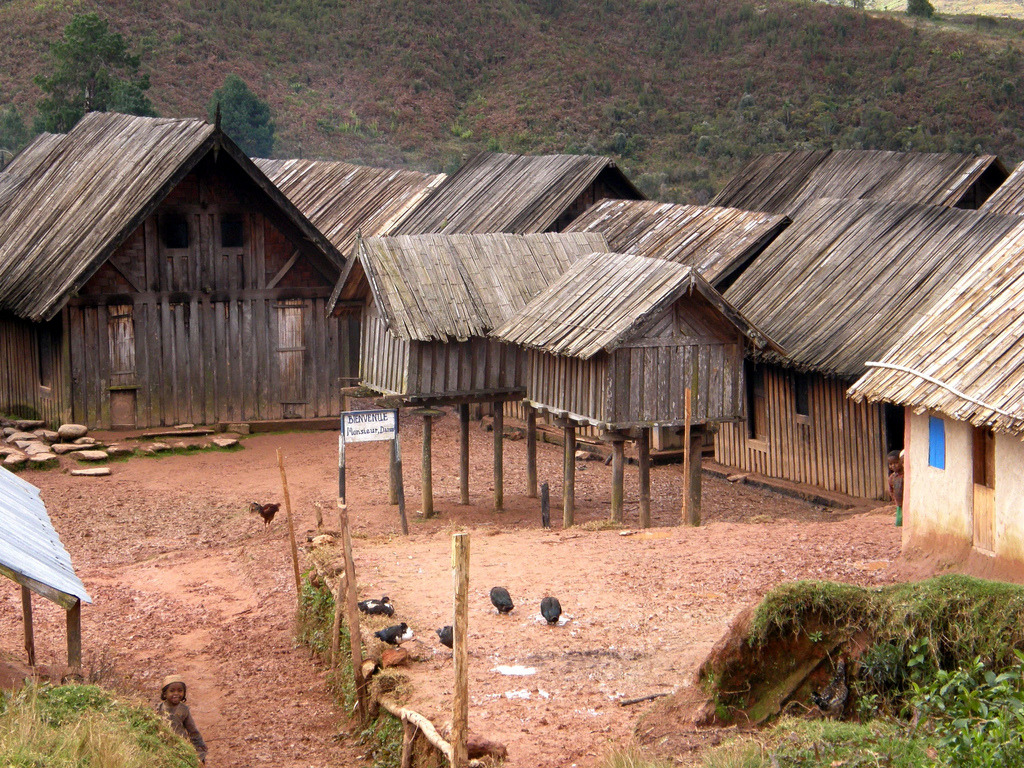
© copepodo / source: flickr.com
TYPES
Structures with similar shapes and made of similar materials are not only found in the vicinity of each other, as was illustrated by the example of the tents called Lavvu by the Sami which resemble the tipis of the American Indians, the tents the Nenets call chums or the yarangas of the Chukchis. In spite of the great distance between these peoples, their different languages and cultures they all live(d) in tents of similar dimensions composed of tree branches leaned against each other to form a pyramidal frame which is covered in animal hides.
The reason for the resemblance is the similarity in the climates of their respective homelands, and the various factors which result from it: the plant life, available food sources, way of life and building materials available. In cold climates the only possible way of life is nomadic animal husbandry, which requires that people move around, living in tents, to find the best grazing for their animals. Only structures which can be easily carried around can be used, and the only materials available are/were animal skins and wood. In difficult weather constructions the simplicity of these tents is a major advantage.
The emergence of tents of this kind is virtually an inevitable consequence of the climatic conditions they developed under, and this kind of process is not unique to the tundra—in other climate zones and biomes buildings evolve in parallel along similar lines, if not quite as markedly. The following section presents the most characteristic types of dwellings in each of the six biomes mentioned above.
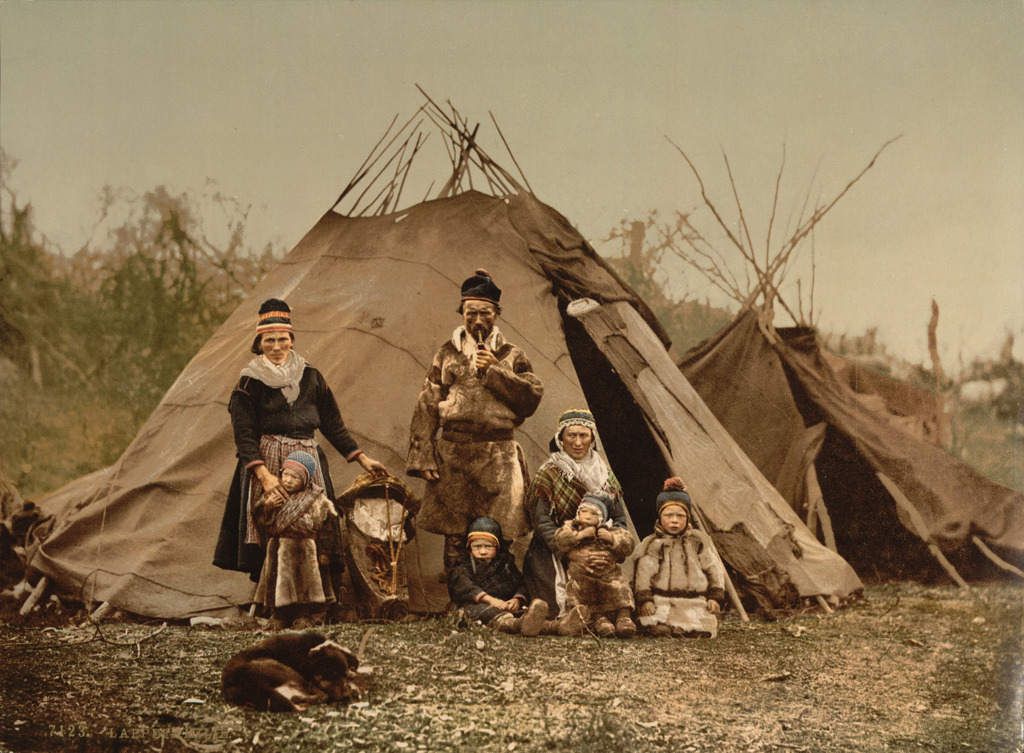
public domain / source: wikipedia.org
Tropical and sub-tropical forested areas
Amazon basin and Central America
Congo basin and the Gulf of Guinea coast
Southeast Asia and Indonesia
These three huge forested regions are uniformly warm all year, but never extremely hot. The lands near the Equator get a lot of rainfall, and while the amount of precipitation declines towards the monsoon forests, there it is rainy for the majority of the year too. In these conditions, forests will spread to cover everything if they are not cut down by humans.
Unlimited quantities of structural timber are available, and plants suitable for roof coverings and partition walls are also plentiful, so other materials are scarcely used. Houses are built only to give shelter from the rain, and so the locals either build houses large enough for the whole community to live and work in together or smaller houses densely packed together, rather than in a one-street village.
In the depths of the rain forests some tribes still subsist by hunting, fishing and foraging, while around their edges, in the less densely vegetated monsoon forests and, last but not least in areas where the rainforest has been destroyed the people live by agriculture. All the tribes who live in these areas employ a mixture of ancient practices and more recently adopted arable farming and animal husbandry, according to the circumstances.
Characteristic types of buildings
Shelter (material: wood and plants)
Hunter-gather-forager peoples will build temporary shelters from the rain when necessary, and always from the materials to hand. The pygmies wander all year round, in each place they stay building themselves half-dome shaped structures out of tree branches, covering them with foliage…and the shelter is ready. In South America, a frame is made from branches and the single sloped roof is covered in large leaves. The simplest type of shelter is that made by the fishermen of the Amazon: the ends of palm leaves are thrust into the sand of the riverbank in a semi-circle so that they lean together and form a rough half-hemisphere
Example: Mashco-Piro temporary dwellings
Ring (material: wood and plants)
If enough single sloped roofs are placed side-by-side for the whole village to fit under, then when it rains (as it does for most of the year!) the community will still be able to function well. What is more, the large roof thus created is ring-shaped, so the space in the middle of this construction is protected from all sides and forms a communal area (a “town square”) for the village. Although they share a single roof, the inhabitants are divided into family groups, cooking around separate fires and sleeping hammocks suspended in family groups. These wooden framed, leaf-covered ring-shaped buildings also appear in variants with pitched roofs.
Example: Yanomami Shabono
Hall (material: wood and plants)
Malocas, the characteristic village halls of South America, are seemingly quite different from shabonos. However, if one imagines a ring that is small enough in diameter for the open central courtyard to disappear completely, and the single-slope roofs to come together, the building obtained would look like a circular Maloca. This kinship is also plausible because not only the materials and structures but also the living arrangements inside are the same as in shabonos. They are generally not circular but usually oval in shape, and there are also rectangular, pitched-roofed Malocas.
Example: Xingu Maloca
Large House (material: wood and plants)
Like Malocas, Longhouses accommodate extended families or village communities under one roof, but not in one undivided communal space. Each family has its own enclosed space, divided from the others, in addition, in most types, to an enclosed and covered communal area of similar dimensions. Longhouses are generally multi-span, stand on stilts, have pitched roofs and are made of bamboo or wood with roofs covered with palm leaves, grass, shingles or bark.
Example: Iban longhouse
Small house (material: wood and plants)
Not only longhouses and halls provide shelter from tropical rains, in Africa and Southeast Asia, but often many single-span houses of various shapes and sizes are also built close to one another (as in single street villages). Although these buildings may be made variously of wood, bamboo, palm leaves, and grass, differ greatly in scale, and may be built on stilts or have enormous roofs, they have several features in common: they are almost all single story and have open-plan, undivided living quarters inside.
Examples: Zafimaniry wooden houses, Niha Ewali, Niha Öri
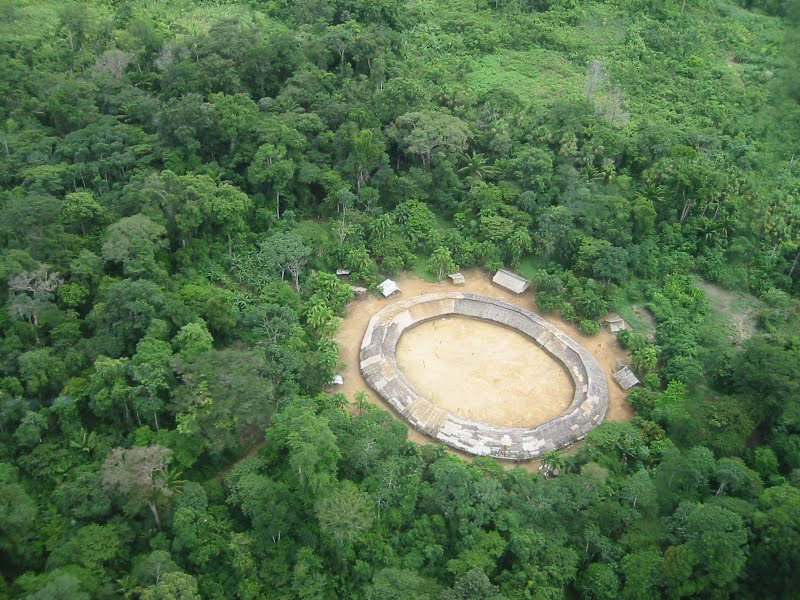
© Marcos Wesley/CCPY / source: pib.socioambiental.org
Other types of buildings
Hut (material: wood and plants)
The constant heavy rainfall in the tropics means that it is not practical to live in separate, free-standing huts. In Southeast Asia, however, huts are built, but with wide roofs with greatly overhanging eaves in all directions, to shelter people walking between the closely packed huts from the rain. Under the deceptively large roofs, families live in quite typically sized dwellings. The houses are made of bamboo, split planks, and various types of grasses.
Examples: Wewewa house, Plank-walled house
Tower (material: wood and plants)
Some tropical buildings are not only high but have several stories. The layout is strictly vertical with each floor usually containing one undivided room, each for a different purpose. Built from various types of wood and plants, these houses are an ancient form of dwelling, where everything is under one roof, or rather stacked one on top of the other, with separate stories for the animals, the human living quarters, granary and the sacred objects of the family.
Example: Manggarai Mbaru Niang
Small house (material: wood and plants)
Extraordinary situations can inspire extraordinary solutions: in the flood plains of the Amazon and the Congo the houses are usually built on stilts (or piles), although some are floating structures and others can be moved in case of floods. Boats are not only for fishing but can be residences too—and houses can be built not only on dry land or on stilts but 50 meters above the ground in the tops of trees if this seems to be the safest bet. These unusual dwellings are normally small, simple and made of wood.
Examples: Raft and Stilt houses of Belén, Bajau Banglo, Korowai treehouse
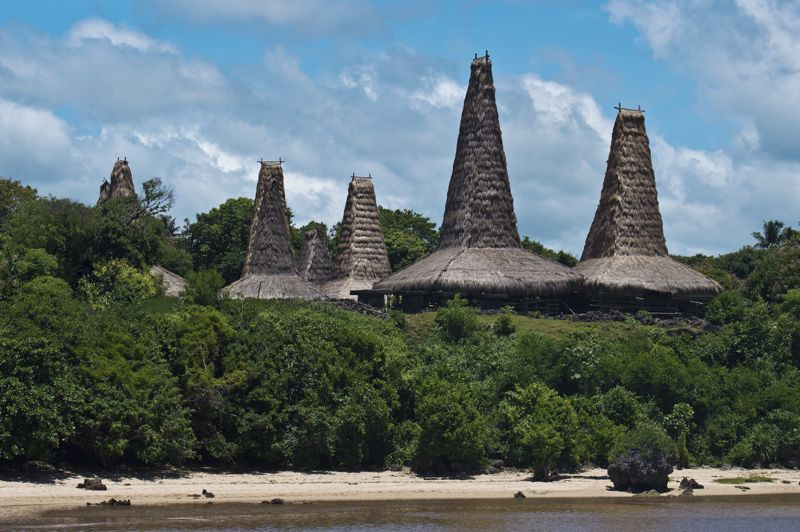
© nao nishimiya / source: flickr.com
Transitional tropical and subtropical areas
The central parts of South America
Most of Africa apart from deserts and rainforests
Northern Australia
There is a continuous transition between tropical forests and deserts. First, the forests thin out and the trees become smaller. Further away they give way to grasslands dotted with bushes. The length of the rainy season also decreases the further you go from the tropical forests, in wooded savannah it is down to half of the year, while in the semi-deserts and deserts there is no rainy season at all.
In rainy regions people can make a living by arable (crop) farming, while in the drier areas animal husbandry becomes a more important source of food. The supply and use of wood changes in a similar way. In the wooded savannahs houses are mostly built of wood, while in the grassy savannahs only the roofs are wooden-framed, and in the semi deserts every part of the buildings have to be made of earth or stone.
The characteristic type of house in the area is the hut, basically with a circular floor plan, although some are also rectangular in shape. As one moves nearer to the drier regions the huts start to be built with fences surrounding them and are built more closely packed together, while on the edges of the deserts there are also cluster type settlements.
Characteristic types of buildings
Hut (materials: wood and plants, single substitution, double substitution)
In transitional tropical and subtropical, the huts are single span, and consequently, they are quite similar in size. Most are circular in plan, rarely square with only the oval Mayan house as an interesting exception. The floor plans dictate the forms of the roofs, which are cones or pyramids, and the roof shape of the unique Mayan house also follows from its layout. The greatest variety is in the materials used: the walls may be built of wooden logs and logs daubed with mud, timber frames filled in with cob, pure cob (stiffened with cow manure) or adobe bricks, stone or a combination of cob/adobe bricks and stone. The frames of the roofs are usually made of wood and can be covered with a wide range of plants. When no wood at all is available the huts are arched and vaulted structures made of stone, cob or adobe bricks.
Examples: Mayan house, Maasai hut, Dorze hut, Musgum hut
Cluster (materials: single substitution, double substitution)
No trees grow at the edge of the transitional area, in the vicinity of the deserts, so only roofs with short spans can be constructed. The types of vaults and arches traditionally employed were also unable to support long spans, so the size of all a building’s elements was limited. To make these buildings seem even more like clusters the men who live in them have several wives: several husbands, many wives, and numerous children live in together polygamous family groups, along with the livestock they keep in the courtyard. The cluster is made up of many small elements with varying uses, built out of cob, adobe bricks and stone.
Example: Bandiagara escarpment dwellings, Gurunsi earth houses
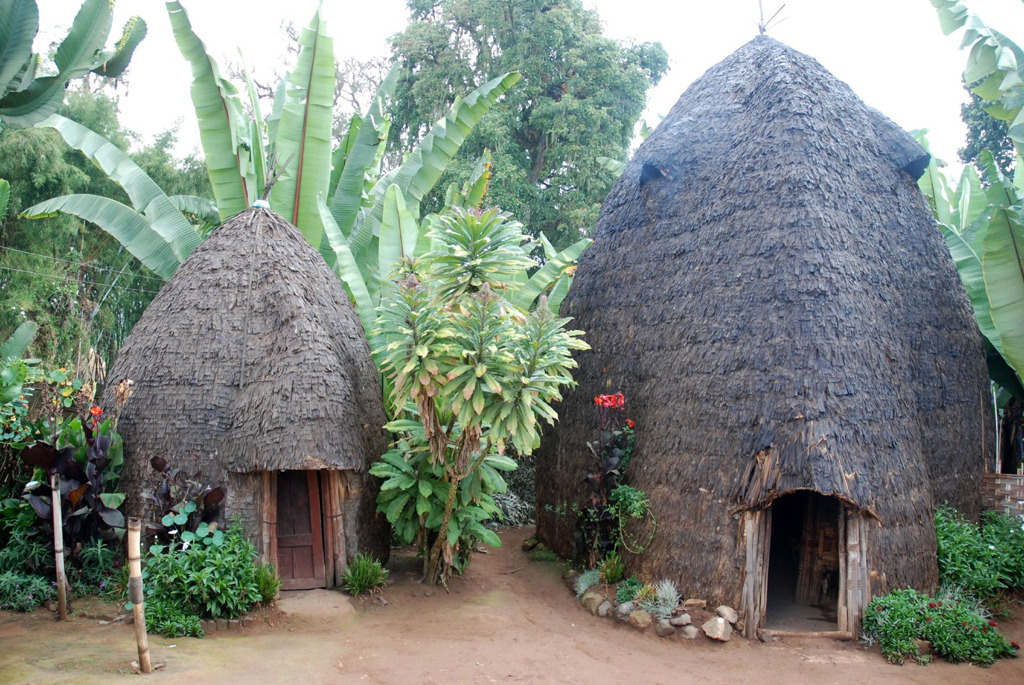
© FrBeBos / source: flickr.com
Dry regions
Southern Rocky Mountains
The Andes
Sahara, Arabian peninsula, Iranian highlands and Central Asia
Kalahari basin
Australian deserts
These five regions are not the same—they include not only hot sandy and rocky deserts, but also cooler, but similarly arid plateaus and mountain ranges. All of them experience great daily variations in temperature, have no vegetation larger than shrubs and large areas that are completely barren.
Semi-arid lands are suitable for nomadic animal husbandry, and this is how the locals live. With the passage of the seasons they must seek out new grazing for their flocks and herds and so move from place to place, living in various kinds of tents and yurts. Apart from portability an important characteristic of these is that often they do not totally enclose the living quarters, but only shade them from the sun. The frame structures of these mobile dwellings generally require little wood, which is covered with woven textiles, felt, reeds or animal hides. Some people in these regions build huts resembling tents out of whatever materials are close to hand, which tend to be rather ramshackle affairs.
When conditions favour it, cave dwellings are also built here, in these areas. Where tunnels can easily be scooped out of soft types of rock this is often exploited, as the large mass of rock totally balances out the differences between daytime and night time temperatures.
Characteristic types of buildings
Tent (materials: wood and plants, single substitution)
The inhabitants of deserts cannot completely eliminate the need for wood, however little is available to them. Short, narrow and gnarled tree branches are used with great ingenuity, as tent frames cannot be made of other materials. The range of tent coverings used is comparatively much more varied. Most are made of plant materials in raw or processed states, but goat, camel and yak hair are also woven to make tent coverings. The sizes and shapes of the tents also vary, as does the number of inhabitants, which ranges from a few individuals to an extended family. Not everything which looks like a tent is a tent: some huts are similar enough to be mistaken for tents, but these are made of materials which are not suitable to be transported and re-assembled elsewhere.
Examples: Kel Ferwan Tuareg tent, Afar tent, Bedouin black tent, Turkmen yurt
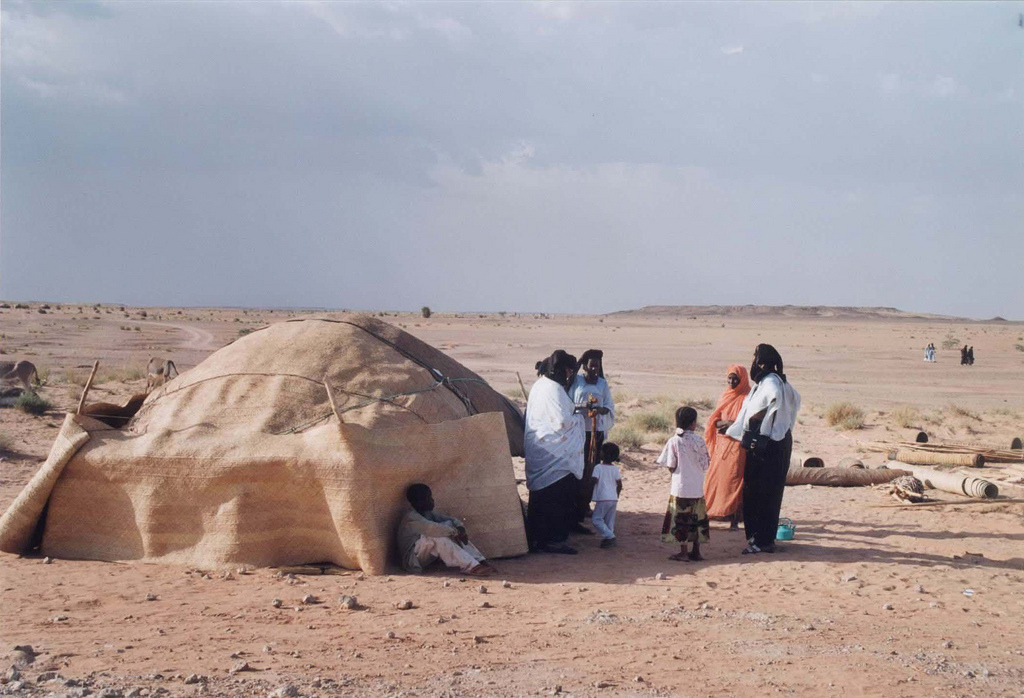
© filouemilie / source: flickr.com
Other types of buildings
Cluster (materials: single substitution, double substitution)
Around the edges of deserts, the need to protect their inhabitants from the worst of the heat and the lack of the wood required gives rise to some quite unique solutions: the dwellings people build here are almost windowless but enclose cavernous, well-ventilated spaces. The multi-story, flat-roofed variant of this is the pueblo of North America, while in Turkey and Syria the Beehive shaped house is its single-story cousin. The range of building materials available is narrow: the walls and vaulted domes of the houses are made of adobe, mud brick and occasionally stone.
Example: Beehive shaped house
Cave (materials: double substitution)
The best defence against great heat and extreme swings in temperature is the large heat capacity. This can be realised to some extent by a house with thick enough walls, but in deserts, caves offer a much better alternative. This approach depends on the type of rock and the topography: freestanding caves are scooped out of steep cliff sides, as in Asia Minor and the Near East, while North Africa is known for its pit houses, where a large round hole is dug several stories down into the rock and the entrances to several caves radiate off it.
Example: Matmata pit houses
Shelter (materials: wood and plants)
The shelters used in deserts and semi-desert differ in function from tropical shelters, shading their inhabitants from the sun rather than the rain.
They are typically temporary dwellings, but may also be used as auxiliary buildings, as with the summer shades erected next to the earth lodges of the Navajo. Their varied shapes derive from whatever trees, bushes and plants are currently available: they may be half domes of twigs, horizontal wooden structures standing on legs or half-cylinders covered in bark. Australia is home to the widest range of shelters, including ones which have elevated floors and stand on stilts, and even “two-story” shelters.
Example: –
Small house (materials: wood and plants)
In hot, dry regions it is not worth building small houses, as their relatively large surface area means that they heat up too quickly. If they are built, it may be due to exceptionally favourable conditions, as is the case with the large bodies of water near Mudhifs. Even the more favourable surroundings are not enough in themselves, as due to the intense sunlight these houses have to be built with high ceilings and good ventilation.
Example: Mudhif
Tower (materials: single substitution)
In none of the various climate zones is it an obvious choice to build and live in towers. These structures are not built due to environmental factors or the building materials available, but almost always as a result of tribal and clan conflicts, as is the case, for example, with the ‘Asir house. The task is to make these fortresses, which often also contain animals, habitable. To this end, the shepherds build thick, high walls with high heat capacity, try to ensure that there is enough cross-ventilation between levels, but even so the inhabitants are sometimes forced to spend the night on the roof terrace of the building, where temperatures are the most tolerable.
Example: ‘Asir house
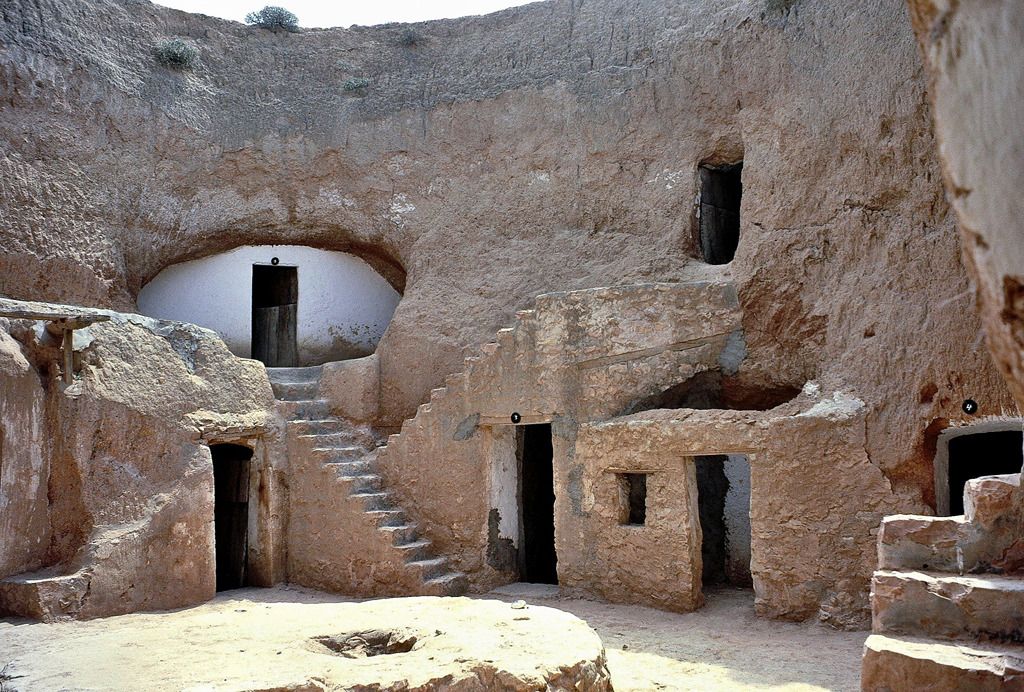
© Patrick / source: flickr.com
Transitional areas of temperate climate zones
Most of the United States of America
Patagonia and the Pampas
The Atlas Mountains, large areas of Europe, Asia Minor, large areas of Siberia, East China
The south of Australia and New Zealand
The regions which are between deserts and temperate climate zones do not precisely match the borders of the biomes, since, as well as steppes and Mediterranean areas. There are also regions that were originally forested but which were transformed by agriculture centuries ago. The means of subsistence are also varied, with arable farming typical of the areas near the forests, while animal husbandry is more common closer to the deserts.
There is a great variety of weather conditions in these areas, and the houses here protect their inhabitants from cold, heat, rain and snow. The materials used for building are also diverse: large amounts of wood are used in the parts closest to the forests while over large parts of these transitional regions the walls are made of stone, cob and adobe, and in the driest regions houses are built entirely of stone or adobe due to the lack of useable timber.
The houses also differ in their shape and form. The most common type in Europe and North America is the small house, but huts and large houses also occur, and in different parts of the world, almost all the forms of houses can be found.
Characteristic types of buildings
Hut (materials: wood and plants, single substitution, double substitution)
Centuries ago many people in Europe still lived in huts. The Pallozas of Spain are the descendents of the round huts which the Celts once built. These dwellings have stone walls, wooden-framed thatched roofs and are often amorphous in their floor plan. In the Mediterranean lands, temporary huts were built in the pastures with stone walls and vaulted roofs, and when several are built together they make a Trullo, which is a permanent residence. In North America, many people lived in earth lodges two hundred years ago. These round houses were made of wood covered in earth, slightly sunken into the earth. The Navajo Hogan, a south-western variant, became extinct at the beginning of the 20th Century.
Examples: Palloza Piornedo, Hidatsa earth lodges
Small house (materials: single substitution, double substitution)
Even in Antiquity round huts were not the only type of houses built in Europe. The small house, which is a single span, pitched roofed building descended from stilt houses and Germanic longhouses, was already widespread at that time. These houses are made of many different materials and proved to be flexible and easily extended, and so became more and more common. In shape and size, they closely follow the original patterns which were made entirely of wood. The wall can be made of whatever materials are available, but the roof structures are generally difficult to reproduce in anything but wood. Difficult, but not impossible: on the island of Santorini the houses have barrel-vaulted stone roofs.
Examples: Scottish black house, Icelandic turf house

© maiscargadadebombo / source: panoramio.com
Other types of buildings
Tent (materials: single substitution)
Contrary to popular belief Tipis, the tents of the Native Americans were not permanent dwellings but were used only during buffalo hunts. For the rest of the year, they lived in earth lodges or longhouses in other areas. Tipis had wooden frames covered in animal hides and resembled European and Asian nomads’ tents. They were easy to set up and transport, and heating and ventilation could be adjusted by altering the position of the covering.
Example: –
Ring (materials: single substitution)
Some buildings are extraordinary in shape, but quite typical in terms of the materials they employ. Tulous are fortified dwellings which each house entire clans. They are round or square in plan with walls several meters thick made of stone, adobe bricks and rammed earth. Wooden living quarters on several stories line the inside of the fortified outer wall, around a central courtyard containing communal buildings. These practically impenetrable fortresses are unknown outside of southern China, but there they still exist in great numbers.
Example: Fujian Tulou
Tower (materials: single substitution, double substitution)
Like rings, towers are exceptional buildings whose main function is defence. In parts of the Caucasus and the Balkans, the local clans were almost continuously at war with each other, forcing families to build towers, and spend long periods of time living in them during times of peril. In the Caucasus massive combat towers were built close to the dwelling towers. The roofs of the combat towers were also made of stone and most of them still survive today.
Example: Vainakh clan towers
Caves (materials: double substitution)
What is true for deserts is no longer the case in temperate zones—here it is not intolerable heat which caves give shelter from. While there is no particular weather-related reason to use caves, where the bedrock is soft enough, or there are suitable loess cliffs the situation is always worth exploiting. In some parts of China, rows of cave-dwellings are dotted along loess cliffs and elsewhere square pits (“sunken courtyards”) are dug into soft rock and cave homes open off these. In Asia Minor, the varying distribution of soft and harder rock determines the shape of the cave systems, but there are also cases of abandoned quarries that are later inhabited.
Example: –
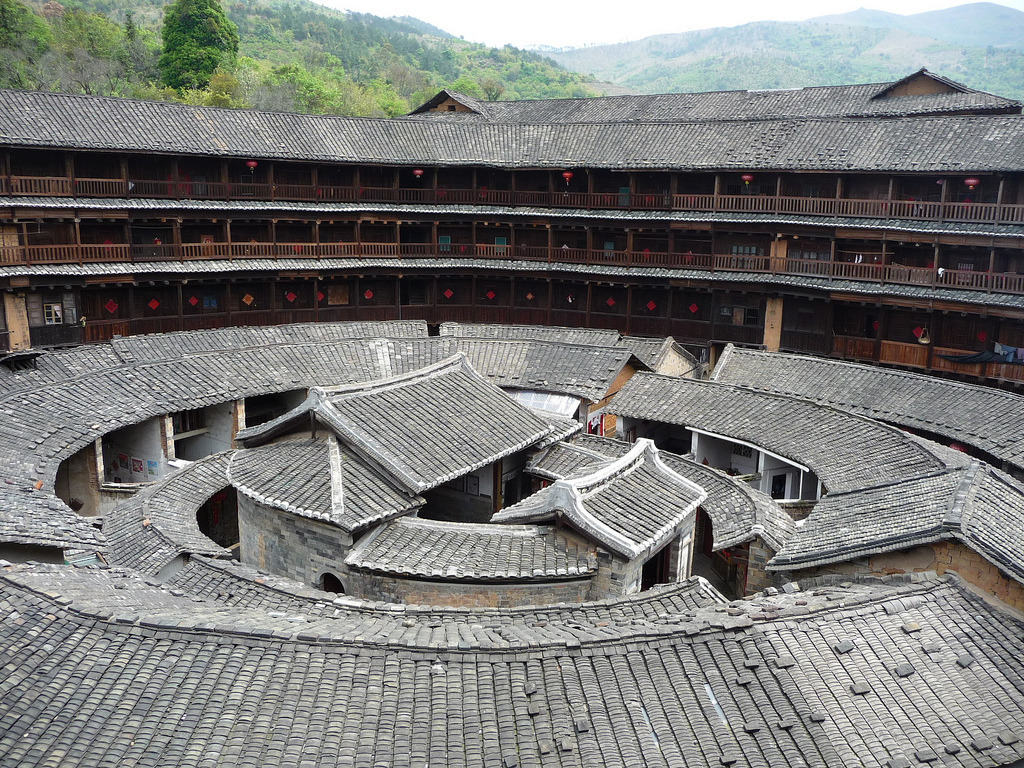
© John Meckley / source: flickr.com
Forested regions of continental and temperate climate zones
Central and southern Canada, northern USA
Scandinavia, Russia (apart from its far North and southern parts), Japan
The climate and vegetation of the North American and Eurasian taiga are similar, with long, cold winters followed by short summers. There is relatively little precipitation, yet it is reasonably wet due to the low temperatures, and marshy areas are common. Like the temperate highlands, the taiga is covered by large, contiguous pine forests. Deciduous forests grow in warmer climates, and today are rarely cover areas comparable in size to the pine forests.
The inhabitants of the forests live by hunting and fishing and gather fruit at the end of the summer. They build robust and well-insulated timber houses (“log cabins”) with wooden roofs covered with earth. Houses which were half dug out of the earth were once typical, but have now disappeared.
Characteristic types of buildings
Small house (materials: wood and plants)
It is no coincidence that the single span houses found in the pine forests of all continental climate zones are all built in essentially the same way. The cool, often cold weather requires good heat insulation, which is best provided by log walls. The straight walls naturally lend themselves to being covered by gabled roofs with frames of wooden beams, which may be covered by various materials: boards, grass, thatch, reed or earth, as in Scandinavia. The houses are often only one-or two-celled and similar in size to huts, but as rooms are added they can grow to greater lengths and may be L-shaped. Despite the similarities in the houses, the settlements in Scandinavia, Siberia, and Japan look quite different from each other, which is further emphasized by the ornamentation characteristic of the region.
Examples: Setesdal farm, Gassho type Minka
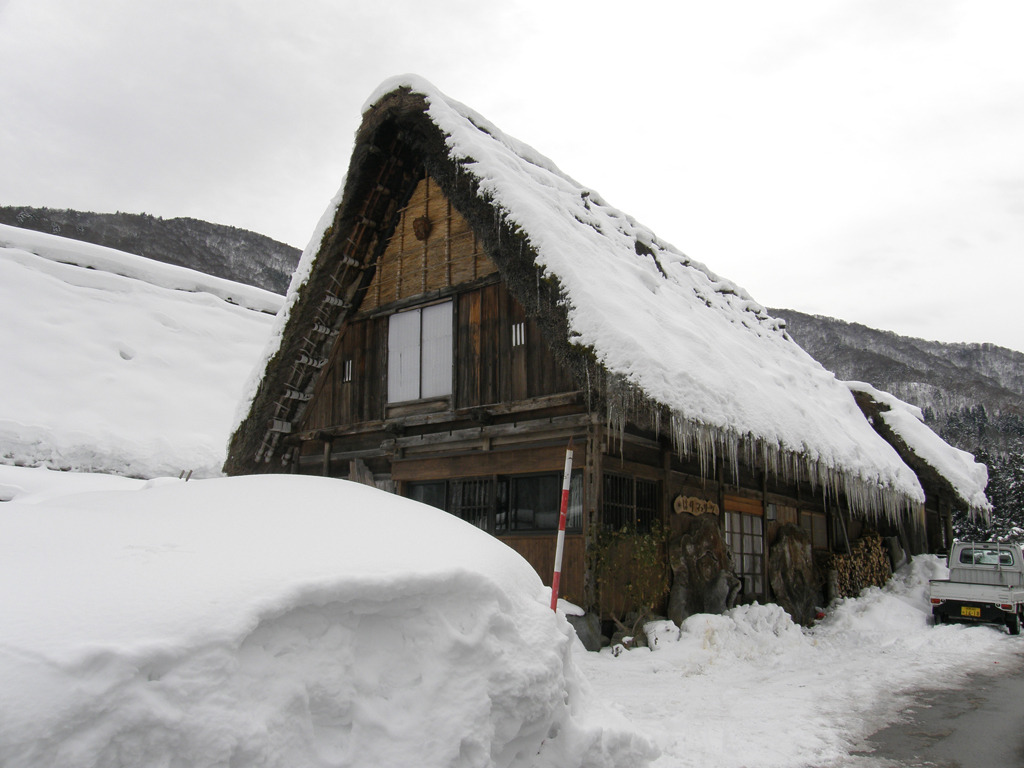
© Bessenyei Krisztina
Other types of buildings
Large house (materials: wood and plants, single substitution)
Large houses can be thought of as a modified form of small house. The Haida longhouse is essentially an expanded, hall-like variant of the small house, in which an extended family lives. The Iroquois longhouses also housed extended families, and their interiors were organised simply as a simple row of family dwellings. The rationally organized Swiss and German hall houses typically housed one family together with large amounts of livestock, crops and fodder The German houses differ from the other types of hall house in having more than one story, and their wooden frames were infilled with bricks or cob.
Examples: Haida longhouse, Iroquois longhouse, Low German Hallhouse
Cold regions
Alaska, Northern Canada and the coastal regions of Greenland
Scandinavia and northern Russia
The coastal regions of Antarctica (uninhabited)
The tundra is the inhabitable part of the Polar Regions. During the long winters all plants stop growing, but in winter the surface of the frozen soil (permafrost) thaws and mosses, lichens and heathers or grasses can grow on it. Only reindeers feed on these plants, so humans survive by nomadic reindeer herding, as well as hunting and fishing.
Winter quarters are sunk into the earth and made of whale bones or wood, while summer dwellings are tents covered in animal furs. Igloos were only temporary shelters made of snow. Nowadays all the traditional types of dwelling apart from tents have disappeared almost without trace, and the local people live in wooden houses.
Characteristic types of buildings
Tents (materials: single substitution)
The only traditional form of building still in use on the tundra is connected to reindeer herding. The tents used by nomadic pastoralists in the region are called tupiks by the Inuit, yarangas by the Chukchi, chums by the Nenets and Lavvus by the Sami, but all of them resemble the tipi of the North American Plains Indians, although they are slightly wider and covered in reindeer hides rather than buffalo skins. They are only used in summer when following grazing reindeer herds, not being suitable for use in the Arctic winter temperatures of minus 30-40 degrees.
Example: Sami Lavvu
Huts (materials: single and double substitution)
When winter came the inhabitants of the tundra abandoned their tents and moved into various forms of winter dwellings. The traditional forms of winter dwellings, the whalebone and wood Valkarans of the Chukchi, half-sunken into the earth, or the houses of the Koryaks have now died out. Similarly, it is no longer possible to find inhabited igloos, the temporary snow hut of the Inuit, as all the peoples of these regions gradually moved into heated wooden houses over the course of the last century.
Example: Chukchi Valkaran
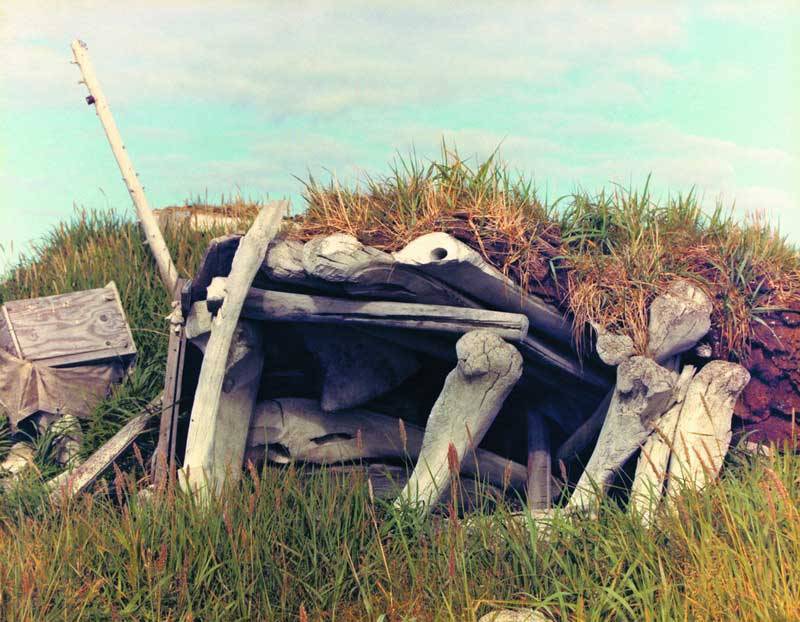
© Majik Imaje / source: hrenovina.net
ORGANIZATION
The 40 examples of vernacular dwellings are drawn from the most varied parts of the world, and care was taken to include characteristic buildings, tents or caves from all the various climatic zones. The buildings are made of natural materials, using earth, stone, plant materials and materials of animal origin in many different ways. The houses vary in size, with some able to accommodate a family, others a clan and still others a whole village. The work done by the inhabitants of these houses is, basically, obtaining food, but the way they achieve this varies: from ancient traditional forms to contemporary techniques.
Several criteria are used to group the 40 examples: the location, climate, the size of the group inhabiting the dwelling, the work done by the inhabitants, the degree of mobility of the dwelling, the materials used and the form of the buildings.
Characteristic building materials
Dwellings grouped by the materials which usually used for structural elements or partitions. There can be more than one type of building material in a dwelling type.
Wood (Bamboo, Coniferous and Broadleaf trees suitable for structural timber) ![]()
Plant (grass, reeds, twigs and all other plant material) ![]()
Textile (leather, felt, woven textiles, carpets and all flat, processed materials of vegetable or animal origin) ![]()
Earth (mud, cob and adobe) ![]()
Stone (all types of stone in all forms) ![]()
Other ![]()
Building forms
Dwellings grouped according to their form.
Cave
Unique/singular cave (not built, merely found) ![]()
Cluster type cave (formed by the characteristics of the rock and topography) ![]()
Linear caves (scooped out of a long cliff face, in regular order) ![]()
Central caves (caves open off a central pit) ![]()
Tent
Conical tent ![]()
Yurt ![]()
Rectangular tent (desert type) ![]()
Domed tent (similar to a desert hut) ![]()
Shelter
Half roof (Single slope or horizontal roof) ![]()
Half-domed (Quarter of a sphere shaped shade) ![]()
House
Hut (single story, single-span compact house) ![]()
Small house (single story, single-span elongated house) ![]()
Tower (multi-story, single-span compact house) ![]()
Ring (single or multi-span, large houses organized around a central courtyard) ![]()
Hall (multi-span, large, centrally structured house) ![]()
Large house (multi-span, large, elongated house) ![]()
Cluster (Building composed of many single span, hut type elements) ![]()

